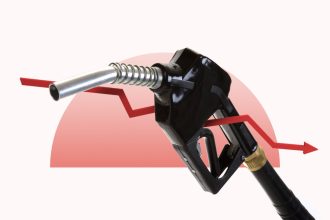10’000 Hours/Getty Images
In most cases, your car insurance policy has strict limits that apply to each portion of your coverage. Once you’ve exhausted those limits, your insurance company won’t pay out any more to cover your damages. But in the case of uninsured motorist coverage, some states permit drivers to “stack” coverage limits for multiple vehicles or policies, resulting in a much higher coverage limit. Bankrate’s insurance editorial team reviews the ins and outs of stacked vs. unstacked auto insurance to help you make an informed decision about your coverage.
What is stacked car insurance?
Stacked insurance means increasing your uninsured and underinsured motorist coverage by combining (or stacking) the limits on each vehicle you own. If you do this, you’ll get a greater amount of financial protection if you get into an accident with a driver who only has your state’s minimum liability coverage (or none at all). However, it’s vital to note that these coverage increases only apply to the bodily injury portion of your policy and not to property damage. For example, if an uninsured motorist hits your vehicle, damaging it and injuring you, your increased coverage from stacking would not pay towards repairing your vehicle, but could help with your medical expenses.
There are two ways to stack your protection. If all your cars are insured on a single policy, uninsured/underinsured motorist coverage can be stacked “vertically” — that is, within the same policy. If your cars are insured under separate policies with the same carrier, the stacked coverage would be considered “horizontal”. Be aware, though, that just because a state allows it does not mean your car insurance carrier will offer policy stacking, vertical or horizontal.
Stacked car insurance on one policy
To effectively stack car insurance within one policy — vertical stacking — you would need to have at least two vehicles on the same policy. For example, let’s say the policy has $25,000 per accident for uninsured motorist bodily injury protection. If you stack your coverage and are insuring two vehicles on your policy, your uninsured motorist bodily injury coverage would extend up to $50,000 per accident. If you had three vehicles on your policy, it would be up to $75,000 for this coverage per accident.
A way to remember stacking in this scenario is that stacking is your uninsured/underinsured motorist coverage limit multiplied by the number of vehicles on your policy. This calculated amount would generally be your new, stacked coverage limit.
Stacked car insurance on multiple policies
Some states also allow horizontal stacking of uninsured and underinsured motorist protection for vehicles that are on different policies, but within the same household and your name is listed on each policy. For example, suppose you have $25,000 in uninsured motorist coverage, and your child also has the same amount of coverage. In that case, you may be able to have $50,000 worth of coverage after an accident involving an uninsured driver who is found at fault. In some states, this is the only way to stack uninsured/underinsured motorist coverage.
Pros and cons of stacked car insurance
Pros
- Increases your coverage limits past what a single policy would accomplish on its own, effectively doubling portions of it.
- It can be invaluable for increasing protection in states with high levels of uninsured and underinsured drivers.
- Higher coverage limits can result in fewer out-of-pocket costs in the event of an auto incident.
Cons
- You may face higher premiums than if you had both policies unstacked.
- Stacked coverage only applies to bodily injury liability coverage for uninsured and underinsured drivers.
What is unstacked car insurance?
Unstacked car insurance is the opposite of stacked car insurance — meaning your uninsured and underinsured motorist coverage limits are not combined, even if you insure multiple vehicles or live with another driver who insures their vehicle. If your car insurance is unstacked, then you would receive up to the uninsured and underinsured coverage limits listed on your policy’s declarations page.
If you live in one of the states below, unstacked car insurance is the only option available to you:
- Alaska
- Arizona
- California
- Connecticut
- Idaho
- Illinois
- Iowa
- Kansas
- Lousiana
- Maine
- Maryland
- Massachusetts
- Michigan
- Minnesota
- Nebraska
- North Dakota
- South Dakota
- Washington
Pros and cons of unstacked car insurance
Pros
- Your premiums will generally be lower with unstacked car insurance.
- Your coverage details may be notably easier to understand and track.
Cons
- With unstacked car insurance, you will have lower coverage limits for dealing with underinsured and uninsured motorists.
- Having lower coverage limits for these auto incidents can increase the risk of having to pay out-of-pocket if an accident occurs.
- It may be more of a hassle and difficulty for multiple-car households to keep policy limits separate.
What states allow car insurance stacking?
Not all states allow stacking, and some may only allow multiple-policy stacking. If your state has a high number of uninsured motorists, it may be worth your while to consider stacking your coverage if possible. This could be especially important if you or any of your frequent passengers don’t have their own health insurance. If your state allows stacked coverage, but your current carrier doesn’t, you could consider switching car insurance carriers to one that offers stacked policies. You may want to speak with your agent to get a quote and see if stacked coverage makes sense for your policy.
Is stacked insurance worth it?
Some may think that more coverage is always better, but it depends on what is important to you as a driver and what fits your budget as a policyholder. Stacked insurance typically comes with a higher premium, which may not make the added financial protection worth it for some drivers. If you’re grappling with the decision between stacked and unstacked insurance, here are some factors to review with your agent:
- Do you have health insurance that you are comfortable using? Your health insurance typically pays for medical bills resulting from a car accident once the uninsured motorist coverage from your insurance policy is exhausted. Drivers with high-deductible health insurance plans may save money by paying for stacked coverage instead.
- Do you frequently have passengers in your vehicle? Uninsured motorist coverage also pays for your passengers’ medical bills. If you regularly have passengers in your car, stacked insurance is a way to help safeguard them from having to use their insurance in the event of an accident.
- Does having stacked insurance drastically increase your premium? Depending on your insurance company, the number of vehicles on your policy, driving history and other factors, stacking insurance may slightly raise your premium. Or it could cause a drastic rate hike. Again, it’s a good idea to talk with your insurance agent to see if the numbers make sense for you.
- Does your policy have personal injury protection(PIP) or medical payments coverage? PIP and medical payments coverage are used as primary coverage—they pay out first at the time of a covered loss. Other insurance coverage on your policy will pay out as secondary coverage, so evaluating your other coverage limits can help you decide.
Frequently asked questions
Why we ask for feedback
Your feedback helps us improve our content and services. It takes less than a minute to
complete.
Your responses are anonymous and will only be used for improving our website.
Help us improve our content
Read the full article here














